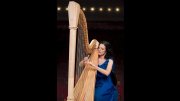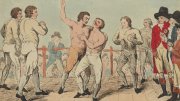When she was six years old, a harp was the most beautiful thing Elisabeth Remy Johnson had ever encountered. That year, her mother took her to a solo concert near their home on Cape Cod, where young Remy Johnson sat in the front row, motionless and mesmerized. After the performance, the harpist invited her up to the stage to take a closer look and run her fingers across the strings. “It was unbelievably thrilling,” she says. That first glissando set the hook.
Almost immediately, Remy Johnson ’95, now the longtime principal harpist of the Atlanta Symphony Orchestra, began a determined march toward her career. She started taking lessons, using a pint-sized rented folk harp with only 15 strings, which gave way to bigger and more complex versions of the instrument—a troubadour, a pedal harp—as her training progressed. In eighth grade, she joined a youth orchestra, and that summer she traveled to Camden, Maine, to spend several weeks learning alongside other young musicians at the world-famous Salzedo Harp Colony. When she returned home, she began lessons with Boston Symphony Orchestra harpist Ann Hobson Pilot.
For years, her life alternated this way: winters with the youth orchestra and her teachers, summers away at orchestra programs. When she arrived at Harvard (“The only place my parents would let me go and be a music major”), a hunger for history and literature led her to add a secondary concentration in French; by the time she graduated, she already had the job offer from Atlanta. A few months after arriving in the city, she played with the orchestra for the opening ceremony of the 1996 Summer Olympics. The composer John Williams, who’d written a piece for the occasion, conducted.
The harp is a notoriously difficult instrument, slippery and subtle, requiring tremendous physical coordination. (Some models have up to seven pedals.) “We’re working with both hands and both feet,” Remy Johnson says, “so to get to a level of clarity in your technique, you have to be willing to put in a lot of time.” Then there’s the fact that few composers, past or present, have been harpists—they’re more likely to be pianists or violinists—and the orchestral parts they write for harp are often literally impossible to play. That means much of the work of being a harpist is finding creative solutions. Remy Johnson won’t name names (even of composers 150 years dead), but “Some of them clearly think we play with all five fingers” (harpists don’t pluck with their pinkies). The “biggest headaches,” she says, “are the ones who know just enough to get them in trouble.”
But the instrument itself remains as mesmerizing to Remy Johnson as ever: “You have that direct contact with the strings, so you can create so many different sounds, so many different moods.” The stereotype of gossamer arpeggios and “the girl in a white dress playing sweet little music” doesn’t begin to capture the real thing. “The best harpists are the ones that explore all the colors,” Remy Johnson says: mournful, frolicsome, eerie, ironic, funny, stern, soaring, swinging. In some recordings, Remy Johnson’s instrument seems almost to cry out; at other times, it purrs.
Several years ago, though, a frustration began to gnaw at her. “I was growing in my awareness of all the female composers out there”—and not just the most famous ones like Fanny Mendelssohn (Felix’s sister) or Clara Schumann (whose picture hangs on the wall in Remy Johnson’s practice room), “but those lost in the archives and those writing today.” She began to wonder why their music is so rarely performed. (A study by the U.K. organization Donne, Women in Music found that of the 16,000 works performed by orchestras worldwide last year, only 7.5 percent were composed by women.) For Remy Johnson, everything came to a head one night while she was scrubbing dishes: “I thought, OK, if they’re not going to do it, we’ll do it ourselves.” And so, in 2018, she and four fellow performers from the Atlanta Symphony—playing flute, oboe, clarinet, and viola—founded the Merian Ensemble, an all-female chamber group dedicated to performing classical works by women. The namesake is Maria Sibylla Merian, a Dutch naturalist and artist whose lavishly detailed drawings of insect metamorphosis preceded the work of Linnaeus and Darwin.
The Merian Ensemble plays a number of concerts and festivals each year, where they premiere works by women that have not found space on other stages. In program notes spoken from the stage, the performers tell stories about the composers. “Sometimes there are some real spicy personalities,” Remy Johnson says. “I love it, helping people today hear from these women.”
In 2021, she released her own solo album of women’s compositions, Quest. Among its tracks are five pieces by Mel (Mélanie) Bonis, a late-Romantic French composer and pianist who attended the Paris Conservatoire at 12 years old, where Claude Debussy was a classmate and her professors declared her brilliant. But when she fell in love with a musician, her parents called her home and arranged a marriage to a much older husband (who didn’t like music). Later in life, she returned to composition, writing some 300 pieces in all. After discovering her story in a French-language biography, Remy Johnson obtained permission to publish some new arrangements of her music. “A lot of her piano music translates over to the harp in a really beautiful way,” she says. The pieces on the album are full of gorgeous, looping harmonies and complex ruminations.
Last August, the Merian Ensemble released its first album, The Book of Spells, a collection of commissioned works by living female composers (with a cover illustration by Merian). Funded by the Atlanta-based Gable Foundation (run by Sally Gable ’61 and Carl Gable ’61, J.D. ’64), the recording includes a piece for solo harp that was inspired by the Harvard Computers, a team of women who mapped the night sky while working at the Harvard College Observatory during the late nineteenth and early twentieth centuries (see “Bringing the Stars to Light,” harvardmag.com/harvard-computers-television-series-21). Written by Brazilian-American composer Clarice Assad, “Solais” is luminous and layered—by turns quiet and contemplative or bursting with wonder, as Remy Johnson’s harp travels brightly up and down the octaves.









